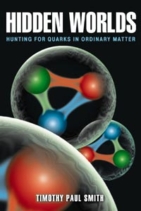by Timothy Paul Smith, Princeton University Press. ISBN 0691057737, £17.95 ($24.95).

The world of subatomic particle physics is often portrayed to the non-specialist as solely the business of large “atom smashing” particle accelerators. But the mysterious quarks are very much the basis of familiar matter in the world about us, as Timothy Paul Smith explains in his book Hidden Worlds.
Smith, a research scientist at the Massachusetts Institute of Technology Bates Linear Accelerator Center and research professor at Dartmouth College, has produced a clear and concise journey through the wonders of subatomic physics for the student. His background as a teacher is soon apparent, as he uses common experiences to help relate the physical scale, details and concepts he wishes to convey. This skill makes the story and its comprehension easy for the lay reader.
Smith quickly introduces his target area and focuses on his quark story. The early pages lead us through the requirement for high-energy accelerators and for their ever-increasing power to explore smaller and smaller particles as the atom, nucleus and nucleons are unwrapped.
The regular comparison and relation of physics concepts to chemistry provides an additional base for the reader’s understanding. The use of quick resumés at the start of each chapter also enables the reader to progress through the book with some certainty – and is helpful for those who cannot complete the book in one go.
Smith uses his own experiences at research laboratories to describe both the scientific method and research team challenge in technical and organizational arenas. His obvious excitement and dedication to the research challenge are very clear, and no high-school student should miss such an invitation to a career.
The book should give the reader confidence in the use of the concepts of – among others – the nucleus, nucleon, charge, spin, color, quark, antiquark and gluon. Smith’s good use of analogies using everyday systems also means that the reader can quickly become confident with the constituent quark and quantum chromodynamics. However, this should not be misinterpreted as gaining a full understanding; this is a small book covering a wide subject area and simply gives an overview in preparation for more advanced work.
The chapter “Particle Taxonomy and Quark Soup” brings us into the Greek alphabet soup, which usually sinks lone attempts at the quark world. Smith’s attitude appears to be that the reader should be exposed to this, but not overwhelmed. Patterns and overview are extracted and we proceed to further discoveries without exhaustion. However, Smith should have expanded more here, as this is the area in which readers are likely to be short of knowledge.
Next, Smith delves into the quark/gluon world, where there is a good use of clear text and diagrams. Having reviewed the quark’s history and the current theories, Smith completes his story with some outstanding questions and current research proposals.
For those of you who flip through a book looking at the ratio of diagrams to text, Smith certainly passes the test, including Feynman diagrams, scale charts, quark and nucleon diagrams, accelerator exploded views and ample graphical charts. A glossary that gives an adequate description of technical terms is also provided, enabling easy reference without having to search through previous chapters.
In all, Hidden Worlds provides a short introduction and overview of the subject area. Students should use it as such and expect to follow up with a more rigorous technical book. It is written in an attractive and easy to read style, which gives the reader the confidence to attack this difficult subject. In my opinion, a copy should be placed in every public library.





